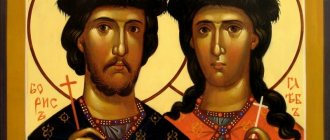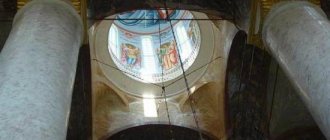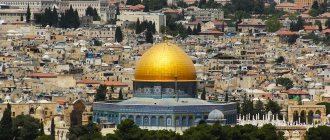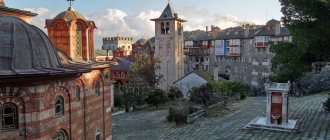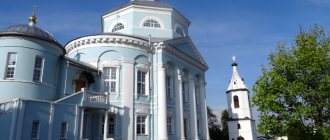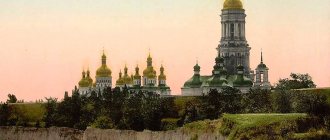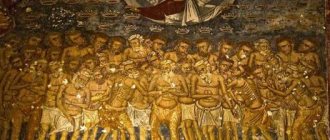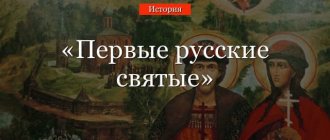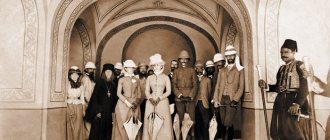| Sebaste martyrs, icon. Novgorod. Saint Sophia Cathedral. "Sofia tablets" Late 15th century |
Saints 40 martyrs who suffered in Lake Sebastia
(c. 320) Commemorated March 9, August 9 (Greek [1], OCA [2])
The memory of the 40 martyrs is one of the most revered holidays. On the day of their memory, March 9, the severity of Great Lent is eased and the Liturgy of the Presanctified Gifts is celebrated.
In 313, Saint Constantine the Great issued the Edict of Milan, according to which Christians were allowed freedom of religion and had equal rights with pagans. But his co-ruler Licinius was a convinced pagan and in his part of the empire he decided to eradicate Christianity, which had spread significantly there. Licinius was preparing for war against Constantine and, fearing treason, decided to clear his army of Christians.
At that time, in the city of Sebastia of Armenia, one of the military leaders was Agricolaus, a zealous supporter of paganism. Under his command was a squad of forty Cappadocians, brave warriors who emerged victorious from many battles. They were all Christians. When the warriors refused to sacrifice to the pagan gods, Agricolaus imprisoned them. The soldiers indulged in fervent prayer and one night they heard a voice: “He who endures to the end will be saved.”
The next morning the soldiers were again brought to Agricolaus. This time the pagan used flattery. He began to praise their courage, youth and strength and again invited them to renounce Christ and thereby gain the honor and favor of the emperor himself. Hearing a refusal again, Agricolaus ordered the soldiers to be chained. However, the eldest of them, Kirion, said: “The Emperor did not give you the right to impose fetters on us.” Agricolaus was embarrassed and ordered the soldiers to be taken to prison without shackles.
Seven days later, the noble dignitary Lysias arrived in Sebastia and held a trial of the soldiers. The saints firmly answered: “Take not only our military rank, but also our lives, for us there is nothing dearer than Christ God.” Then Lysias ordered the holy martyrs to be stoned. But the stones flew past their target; a stone thrown by Lysias hit Agricolaus in the face. The torturers realized that the saints were protected by some invisible force. In prison, the soldiers spent the night in prayer and again heard the voice of the Lord comforting them: “He who believes in Me, even if he dies, will live. Be bold and do not be afraid, for you will receive imperishable crowns.”
The next day, the trial before the torturer and the interrogation were repeated, but the soldiers remained adamant.
| Sebaste martyrs, icon. Bulgaria. Second half of the 18th century. |
It was winter, there was severe frost.
They stripped the holy warriors, led them to a lake located not far from the city, and placed them under guard on ice for the whole night. To break the will of the martyrs, a bathhouse was lit nearby on the shore. In the first hour of the night, when the cold became unbearable, one of the warriors could not stand it and ran towards the bathhouse, but as soon as he crossed the threshold, he fell dead. At three o'clock in the morning, the Lord sent consolation to the martyrs: suddenly it became light, the ice melted, and the water in the lake became warm. All the guards were asleep, only one named Aglaius was awake. Looking at the lake, he saw that a bright crown had appeared over the head of each martyr. Aglaius counted thirty-nine crowns and realized that the fleeing warrior had lost his crown. Then Aglaius woke up the rest of the guards, took off his clothes and told them: “And I am a Christian!” - and joined the martyrs. Standing in the water, he prayed: “Lord God, I believe in You, in whom these soldiers believe. Join me to them, so that I may be worthy to suffer with Your servants.” The next morning the torturers were surprised to see that the martyrs were alive, and their guard Aglaius was glorifying Christ with them. Then the soldiers were taken out of the water and their legs were broken. During this painful execution, the mother of the youngest of the warriors, Meliton, urged her son not to be afraid and to endure everything to the end. The bodies of the martyrs were placed on chariots and taken to be burned. Young Meliton was still breathing, and he was left lying on the ground. Then the mother picked up her son and carried him on her shoulders after the chariot. When Meliton breathed his last, his mother laid him on a chariot next to the bodies of his holy companions. The bodies of the saints were burned at the stake, and the charred bones were thrown into the water so that Christians would not collect them.
Three days later, the martyrs appeared in a dream to Peter, Bishop of Sebaste, and ordered him to bury their remains. The bishop and several clergy collected the remains of the glorious martyrs at night and buried them with honor.
In 438, by divine vision, the relics of the saints were found and, by order of Empress Pulcheria, placed in two silver crayfish in the Church of St. Thirsus in Constantinople. Subsequently, by order of Pulcheria, behind the walls of the “Trojan Rams” (τῶν Τρωαδησίων Ἐμβόλων), a temple was built in honor of the martyrs near the Golden Gate.
The names of the martyrs have been preserved: Kirion, Candide, Domnus, Hesychius, Heraclius, Smaragd, Evnoikos, Valens (Valens), Vivian, Claudius, Priscus, Theodulus, Eutyches, John, Xanthius, Ilian, Sisinius, Angius, Aetius, Flavius, Acacius, Ecdicius (Ecditus), Lysimachus, Alexander, Ilius, Gorgonius, Theophilus, Dometian, Gaius, Leontius, Athanasius, Cyril, Sakerdon, Nicholas, Valerius (Valerius), Philoctimon, Severian, Hudion, Melito and Aglaius.
| 40 mph. Sevastian. Fresco from 1547 in the Dionysiates Monastery, Athos. By Zorzis Fuka |
Lives of the 40 Martyrs of Sebaste
The Forty Martyrs of Sebaste are the saints of the first centuries of Christianity. Their lives left a deep mark on the history of the faith of Christ. In 313, the Roman Emperor Saint Constantine the Great gave Christians freedom. But there was also a second ruler in Rome - Licinius. An ardent pagan, he not only planned to resume the persecution of believers in Christ, but also prepared to betray Constantine and become the sole emperor of Rome. The traitor decided to start the massacres with the military, among whom there were many followers of the Savior.
In the city of Sebastia there was just one of these - Christian - troops. Under the command of the pagan Agricolaus there was a whole squad of Christians - forty warriors, glorified by many victories. At the instigation of Licinius, Agricolaus tried to force them to sacrifice to the pagan gods, but they refused, for which they were thrown into prison. There the soldiers prayed to Christ, and it was revealed to them that “he who endures to the end will be saved.”
The next morning, the insidious Agricolaus again tried to persuade the army to renounce the Savior. But he failed the second time. Christians were again thrown into prison. A week later they were tried. The brave warriors answered the pagan court firmly: “Take not only our military rank, but also our lives, for us there is nothing more precious than Christ God.”
They wanted to stone the martyrs, but the cobblestones did not reach them - as if the Holy Spirit himself was protecting them from death. And again they imprisoned Christians. During prayer they heard: “He who believes in Me, even if he dies, will live. Be bold and do not be afraid, for you will receive imperishable crowns.”
Fresco of the temple of the Church of the Blessed Virgin Mary Asinu, Cyprus, 12th century. Photo by Maria Cherkashina
And so, when a frosty winter day arrived, the martyrs were led to a local lake and left there in custody, naked, right on the ice, where cold water splashed. A bathhouse was lit nearby so that in the agony of death the soldiers would renounce Christ and exchange Him for warmth... But only one of the sufferers could not stand it and ran to the bathhouse - and immediately fell dead in front of it.
In the morning, when one of the guards woke up, he saw shining halos above the heads of each of the thirty-nine Christians. Realizing why there were only 39 crowns, he exclaimed: “And I am a Christian!” — took off his clothes and stood next to the soldiers. In the morning, the soldiers and the guard were taken out of the lake and their legs were broken. Then their bodies were taken in chariots to the fire and burned.
When three days had passed after the execution, Bishop Peter of Sebastia saw the holy warriors in a dream - he was told to bury their remains. Together with his assistants, he collected the holy relics one by one and interred them with prayer.
Features of the legend - theological interpretation
These events, which were mentioned in their sermons by Basil the Great, Gregory of Nyssa and Ephraim the Syrian, teach Christians to rely in everything on the will of the Lord. His grace gives strength to endure any hardships and obstacles - even those that seem to exceed human capabilities. The wonderful light that warmed the water and air around the warriors came from their souls, purified during their asceticism. This means that long-suffering, humility and firmness in faith can defeat any evil!
Trials are not always as terrible as in the example described - much more often the devil tempts believers with minor problems, worries, and troubles. They do not require either an explicit renunciation of Jesus Christ or the trampling of the fundamental principles of life - however, every day they undermine moral foundations more and more, force them to sin and deviate from the commandments given by the Creator. It is carelessness, carelessness and carelessness in such matters that is the scourge of modern man.
Therefore, the prayer to the 40 Martyrs of Sebaste, supplemented by sincere repentance, participation in divine services, careful fasting and zealous fulfillment of Christian duty, allows us to increase the grace received through the sacraments of baptism, confession and communion. It eliminates unbelief, apathy, grief, despair and sadness, brings peace, happiness and peace, drives away wicked thoughts and bad habits. By calling on ascetics, people gain the determination to change something in their lives, choose the righteous path, and make decisions in difficult situations.
In front of the icon depicting Roman soldiers, they ask for the courage and bravery necessary to endure any troubles. Heavenly patrons provide spiritual assistance to everyone who is in captivity, suffering from persecution, insults, and ridicule. Women whose husbands spend a long time on business trips and work trips also turn to them. And under the intercession of the martyrs are Christians who received the same name at baptism - the saints tirelessly accompany their charges, protecting them from dangers, illnesses and worries.
In addition, this image symbolizes the willingness to defend one’s beliefs, as well as to instill them in other people - relatives, children, acquaintances. Only then will the light of true faith spread throughout the world, saving souls from doubts, suffering, and vicissitudes of fate.
Temple of the 40 Martyrs of Sebaste
The Temple of the 40 Martyrs of Sebaste is located in Moscow near the Novospassky Monastery. The exact address of the temple: Dinamovskaya street, building 28.
In 1640, here on Taganka, Tsar Mikhail Fedorovich Romanov, the first tsar of this illustrious dynasty, determined that masons - the builders of the walls of the monastery and the monastery's Transfiguration Cathedral - would live here.
When the construction work ended, the masons did not go anywhere and settled here on Taganka. It was their craft that gave the name to two neighboring streets - Big and Small Masons. And soon, in 1645, not far from the entrance to the monastery, a new temple grew up - the 40 Martyrs of Sebaste.
Fresco of the temple of the Church of the Blessed Virgin Mary Asinu, Cyprus, 12th century. Photo by Maria Cherkashina
Reverence
The day of remembrance of the Forty Martyrs of Sebaste in Orthodoxy is March 9/March 22. In honor of the holy warriors, restrictions during Lent are being eased. This is one of the most revered holidays, therefore, at the evening service in the church, Communion is celebrated with the Holy Gifts, consecrated at the previous liturgy.
The memorable date was established by the Bulgarian ruler Ivan II Asen in 1230. He fought with the Thessalonian emperor Theodore Komnenos Ducas. Ivan prayed to the forty Sebastian martyrs and won victory on March 9th. To glorify the holy intercessor warriors, the Bulgarian built a church in their honor. The temple is still located in the city of Veliko Tarnovo, the former capital of Bulgaria.
The Day of Remembrance of the Forty Martyrs of Sebaste is considered a holiday for all Orthodox men. Also, the memorable date coincides with the Slavic folk festival of magpies, associated with the arrival of spring and the return of larks and waders. For the holiday, baked goods are baked in the shape of birds. Baked “larks” symbolize the souls of martyrs flying to God.
The existence and veneration of the feast of the forty martyrs of Sebaste is known thanks to the sermons of the saints and brothers Gregory of Nyssa and Basil the Great. In their family, martyrs were revered saints. The parents of the saints are buried next to the resting place of the relics of the holy Cappadocian warriors.
On the day of remembrance of the Sebastian warriors, Christians prayed to the Albazin Icon of the Mother of God in gratitude for all the gifts that the Lord sends and women who dream of motherhood.
Prayers to the Holy Forty Martyrs of Sebaste
First prayer
About the holy glory of the passion-bearers of Christ, the fourty, in the city of Sebastia, for the sake of Christ, who courageously suffered, through fire and water, and as the friends of Christ entered into the peace of the Heavenly Kingdom, have great boldness to intercede with the Most Holy Trinity for the Christian race: especially for those who honor your holy memory , and calling you with faith and love. Ask the all-merciful God for forgiveness of our sins and correction of our lives, so that in repentance and unfeigned love for each other, having lived with each other, we will boldly appear before the terrible judgment seat of Christ, and through your intercession we will appear at the right hand of the righteous Judge. To her, saints of God, be our protectors from all enemies, visible and invisible, so that under the shelter of your holy prayers we will get rid of all troubles, evils and misfortunes until the last day of our life, and thus we will glorify the great and venerable name of the all-powerful Trinity, the Father and the Son and the Holy Spirit, now and ever and unto ages of ages. Amen.
Second prayer
O passion-bearers of Christ, who courageously suffered in the city of Sebaste, we earnestly resort to you as our prayer books and ask: ask the All-Bounteous God for forgiveness of our sins and correction of our lives, so that in repentance and unfeigned love for each other, having lived together, we will boldly present ourselves to the terrible judgment of Christ and through your intercession we will stand at the right hand of the Righteous Judge. To her, God's servants, awaken us, God's servants (names), protectors from all enemies visible and invisible, so that under the shelter of your holy prayers we will get rid of all troubles, evils and misfortunes until the last day of our life, and thus glorify the great and venerable name of the Almighty Trinity, Father and Son and Holy Spirit, now and ever and unto ages of ages. Amen.
Traditions and rituals
The main traditions of March 22 are prayers to the Sebastian martyrs for the successful completion of military service, and baking buns in the shape of birds.
- In Rus', for this day, housewives baked cookies in the shape of birds from dough, usually forty pieces - according to the number of martyrs who died. For this, elastic, well-kneaded dough was used, and sweet, strong tea was used as a lubricant. They gave cookies to the children, saying: “The larks have flown in and landed on the children’s heads.” The children climbed onto the roofs, tied the “larks” to poles and called on the birds to come quickly and bring spring. Then the baked goods were crumbled and scattered to the sides.
“However, spring could be deceptive - the morning frosts were still strong. If there was a morning frost on March 22, they said that Soroki had begun - forty frosty days. To protect themselves from “matinee parties,” housewives baked forty balls from rye or oatmeal. They said about them: “Saint magpies, golden kolobans.” The balls were supposed to be thrown out of the window one per day for forty days.
— The youth had their own fun and games on this day. They were going to a dance. First, the girls performed the ritual of closing winter and opening spring. They tore forty ropes or broke forty sticks. This action, according to our ancestors, broke the bonds of evil spirits that bound the earth in winter and contributed to the onset of spring. Then mass celebrations began.
Icon of the 40 Martyrs of Sebaste
In the center of the icon of the 40 Sevastian martyrs we see the warriors themselves. They are standing on an icy lake - naked. Some support others, some are trying to somehow escape the frost - their figures are depicted in dynamics. Also on the icon we see the figure of the fortieth warrior, who retreated from faith in the Savior and rushed to the bathhouse, which the guards assigned to the martyrs specially melted for temptation. The face of the apostate is not written on the icon - it is a symbol of his betrayal.
In the lower corner of the icon, icon painters depict the guard Aglaiya. It was he who became the fortieth martyr in place of the apostate when he saw shining halos above the heads of the soldiers. Also on the icon is the image of the Savior, who overshadows the saints with a blessing gesture.
Iconography
In the bell tower of the Church of the Holy Sepulchre, there is the Church of the Forty Martyrs of Sebaste, and there is an icon depicting the plot of the legend about the warriors. Some martyrs stand in the water, others are tormented on the shore.
In the foreground is Meletios on his way to the bathhouse, with a guard standing outside the door. To the left, a white city spreads out in the greenery; a little higher up is a detachment of warriors in armor, with shields and spears. But they stand with their backs to what is happening in the water and on the shore.
In Berlin, the Bode Museum houses a 10th-century Byzantine bas-relief. The faces and poses of the forty martyrs are not made according to a template, therefore they do not depersonalize, but convey the character of each of them.
There are two types of images of the Saints of Sebastia:
- episode on the river;
- individual images on medallions.
Personal icons often depict Saint Kirion of Sebaste as the eldest of forty warriors - in a red or blue cloak, with a cross in his right hand.
Signs and sayings
- If the magpies are warm, forty days will be warm; if they are cold, expect forty cold mornings.
- On Soroka, day and night are measured and equal.
- What the Magpies look like, so do the Petrovkas.
- If the frost lasts forty days, then it will be warm in the summer.
- The frost that occurred on March 22 promises a harvest, especially millet.
- What is the weather like in Soroka, it will be like this for another forty days.
- Thunder is heard - for a hungry year.
- A warm wind promises a rainy summer.
- Jackdaws and magpies are found in large numbers, which means it will soon be warm.
- The seagull has flown in - soon the ice will melt, spring will begin, the lark has flown in - to the warmth, the finch - to the cold.

